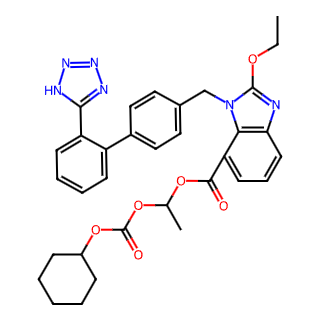- Synthetic anti-infective drugs
- Medications for the digestive system
- Antipyretic and analgesic drugs
- Medications for the blood system
- Medications for the respiratory system
- Anti-allergic drugs
- Medications for the urinary system
- Diagnostic medications
- Immunosuppressive and immunomodulatory drugs
- Vitamins and mineral supplements
- Antioxidants and medications for osteoporosis
- Antiparasitic drugs
- Ophthalmic medications
- Amino acids and their derivatives
- Dermatological medications
- Medications for the circulatory system
- Antitumor drugs
- Medications for the nervous system
- Hormonal and endocrine function-regulating drugs
- Antibiotics
- Others
CAS NO.: 145040-37-5




Basic Information
Chinese Name: 坎地沙坦酯
English Name: Candesartan Cilexetil
CAS Number: 145040-37-5
Molecular Formula: C33H34N6O6
Molecular Weight: 610.66000
EINECS Number: 627-030-2
Physical Properties
Melting Point: 159°C (some sources indicate 168-170°C)
Density: 1.37 g/cm³
Solubility: Slightly soluble in methanol, very slightly soluble in ethanol
Chemical Properties
Stability: Generally stable under normal conditions
Possibility of Hazardous Reactions: No specific reactivity reported
Materials to Avoid: Oxidizing agents
Hazardous Decomposition Products: Carbon monoxide, carbon dioxide, nitrogen oxides (NOx)
Uses
Candesartan siladide is an angiotensin II receptor (AT1) antagonist used to treat hypertension. It is a prodrug of Candesartan, which exerts its effect by blocking the angiotensin II receptor in vascular smooth muscle, thereby reducing peripheral vascular resistance. Candesartan cilexetil is 10 times more potent than Losartan, with a high selectivity (over 10,000 times higher affinity for AT1 receptor than AT2) and a long duration of action (requiring only once-daily dosing). It also exerts a mild antihypertensive effect by inhibiting aldosterone secretion from the adrenal gland.
Safety Information
First Aid Measures:
Skin Contact: Remove/take off immediately all contaminated clothing. Rinse skin with plenty of water and soap. Seek medical attention.
Eye Contact: Rinse cautiously with water for several minutes. Seek medical attention.
Ingestion: Seek medical attention. Rinse mouth.
Protection of First Aiders: Wear appropriate personal protective equipment, such as rubber gloves and airtight goggles.
Fire Fighting Measures: Suitable extinguishing media include dry powder, foam, water spray, and carbon dioxide. Combustion or exposure to high temperatures may produce toxic fumes. Fight fire from a safe distance and with protective equipment.
Accidental Release Measures: Use special personal protective equipment (e.g., P3 particulate filter respirator for toxic particles). Isolate spill area with warning tape. Keep unauthorized personnel away. Collect dust by sweeping and shoveling, then place in a closed container. Do not disperse.
Storage Conditions
Keep container tightly closed and locked. Store away from incompatible materials such as oxidizing agents.
Where possible, install closed systems or local exhaust ventilation. Use respiratory protection such as dust masks or self-contained breathing apparatus (SCBA) and eye protection such as goggles.

Tai Yau Street, San Po Kong, Kowloon, Hong Kong, China.



